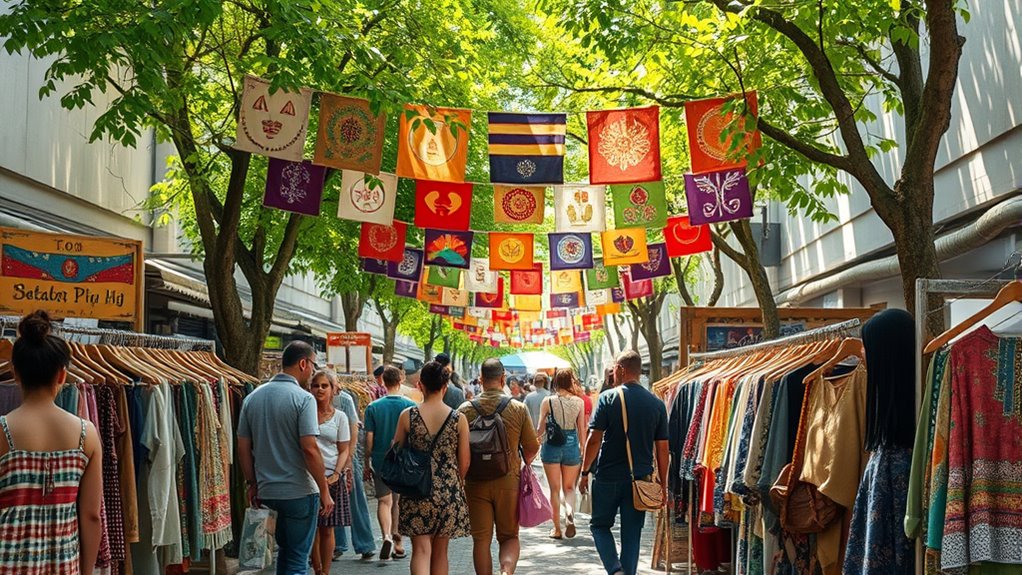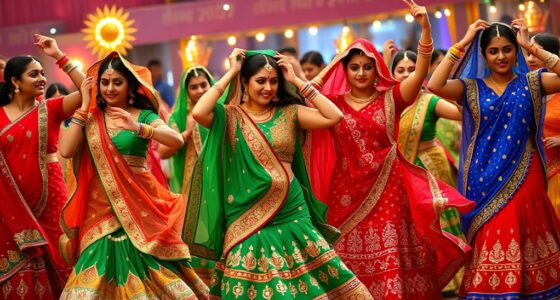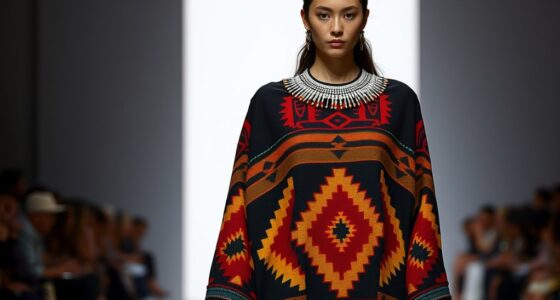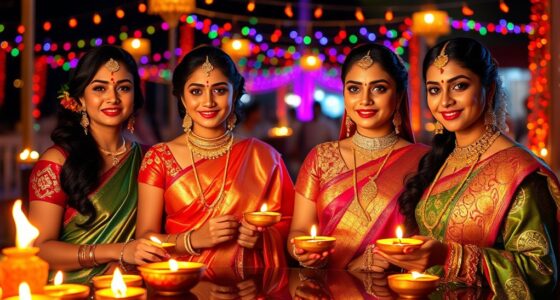Circular fashion blends traditional symbols, craftsmanship, and stories to honor cultural identities while promoting sustainability. By choosing pieces rooted in cultural significance, you support artisans and help preserve diverse heritage through eco-friendly practices. This approach encourages responsible consumption, making fashion more meaningful and lasting. If you want to see how these elements shape sustainable style and cultural preservation, there’s much more to discover below.
Key Takeaways
- Circular fashion integrates traditional motifs and symbols, preserving cultural identities through sustainable design practices.
- Emphasizes artisanal craftsmanship, ensuring authentic, durable garments that honor cultural heritage.
- Promotes sustainable lifecycle practices, encouraging reuse, longevity, and reducing fashion waste.
- Supports cultural diversity by maintaining traditional techniques and storytelling within modern fashion contexts.
- Fosters a responsible fashion ecosystem that balances environmental sustainability with cultural preservation.
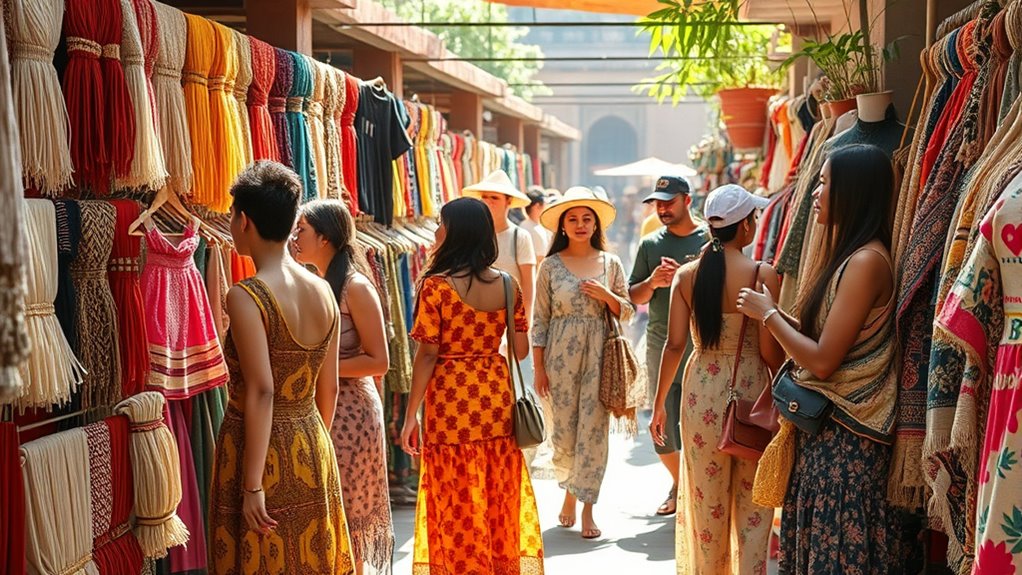
As the fashion industry shifts toward more sustainable practices, circular fashion has emerged as a transformative approach that combines environmental responsibility with cultural relevance. You’re not just wearing clothes; you’re participating in a movement that values cultural symbolism and traditional craftsmanship. This shift encourages you to look beyond fast fashion trends and appreciate garments that tell stories rooted in heritage, community, and artisanal skills. When you choose circular fashion, you’re supporting designs that incorporate cultural symbolism—motifs, patterns, or techniques significant to specific communities or regions. These elements serve as more than decoration; they carry meanings, histories, and identities that connect you to a broader cultural narrative. By embracing these symbols, you help preserve cultural diversity within the fashion landscape, ensuring that traditional stories and identities aren’t lost to mass production.
Furthermore, circular fashion often emphasizes traditional craftsmanship—skills passed down through generations that create one-of-a-kind pieces with a sense of authenticity and depth. Instead of mass-produced, uniform items, you get garments that showcase meticulous handiwork, reflecting the patience and expertise of artisans. This focus on craftsmanship not only elevates the quality of your wardrobe but also reduces waste, since well-made, durable clothing lasts longer. When you invest in pieces crafted with traditional techniques, you’re promoting sustainable practices that prioritize longevity and reuse over fleeting trends. These garments often involve processes like hand embroidery, weaving, or tailoring that can’t be easily replicated by machines, making each item uniquely valuable.
Choosing circular fashion also means appreciating the lifecycle of your clothing. You’re encouraged to buy less but better—favoring pieces that can be reused, repurposed, or passed down, thereby reducing environmental impact. This approach fosters a deeper connection to the cultural significance embedded in each garment, reminding you of the artisans and communities behind the craft. It’s about creating a dialogue between the past and the present, where traditional craftsmanship and cultural symbolism are celebrated as essential components of sustainable style. By doing so, you help cultivate a fashion ecosystem that respects both the environment and cultural identities, ensuring that these rich traditions endure amid a rapidly changing industry. Ultimately, your choices in circular fashion become a conscious act of preserving cultural heritage while advocating for a more sustainable, responsible future.
Frequently Asked Questions
How Do Circular Fashion Practices Vary Across Different Cultures?
You’ll notice circular fashion practices vary across cultures by emphasizing different cultural symbolism and fashion rituals. In some societies, repurposing textiles reflects respect for tradition, while in others, sharing or passing down clothing symbolizes community bonds. These practices influence sustainable choices, blending cultural identity with eco-friendly habits. By understanding these diverse traditions, you can appreciate how circular fashion adapts uniquely to each culture’s values and rituals, fostering global sustainability.
What Role Do Indigenous Communities Play in Sustainable Fashion?
You hold the key to a treasure chest of indigenous knowledge, which lights the path toward sustainable fashion. Indigenous communities play a crucial role by weaving cultural preservation into eco-friendly practices, transforming tradition into innovation. Their age-old techniques and deep respect for nature inspire circular fashion, turning garments into stories of harmony and resilience. Embracing their wisdom helps nurture a future where fashion respects both people and the planet.
Can Circular Fashion Influence Global Economic Disparities?
Yes, circular fashion can influence global economic disparities by promoting fair trade practices and reducing waste. You might see how it encourages local economies, especially in developing countries, by creating new opportunities for sustainable jobs. As circular systems emphasize resource-sharing and recycling, they can help diminish economic inequality, fostering more equitable global trade. This shift encourages responsible consumption and supports marginalized communities, ultimately narrowing the gap between wealthy and less advantaged regions.
How Does Circular Fashion Affect Traditional Craftsmanship and Artisanship?
Like a river shaping its banks, circular fashion gently influences traditional craftsmanship and artisanship. You see, it promotes artisan preservation by valuing handmade techniques, while also encouraging craft innovation to meet modern needs. This balance helps artisans stay relevant, preserving cultural identities, and fostering sustainable practices. As a result, circular fashion empowers artisans, blending tradition with creativity, and ensuring their skills thrive in a changing world.
What Are the Challenges in Implementing Circular Fashion in Developing Countries?
You’ll face challenges like supply chain complexities and limited consumer awareness when implementing circular fashion in developing countries. Managing complex logistics, sourcing sustainable materials, and establishing recycling systems can be tough. Additionally, raising consumer awareness about the benefits of circular fashion is vital but often overlooked. Overcoming these obstacles requires education, infrastructure development, and collaboration to create a sustainable, circular fashion ecosystem that benefits local communities and the environment.
Conclusion
So, you thought fast fashion was just about cheap clothes? Think again. Embracing circular fashion means you’re suddenly a cultural trendsetter, championing sustainability while avoiding landfill chaos. Ironically, by turning away from wasteful practices, you might just find yourself caught up in the very cycle you’re trying to break. But hey, at least you’ll look good while saving the planet—what’s more fashionable than that?
